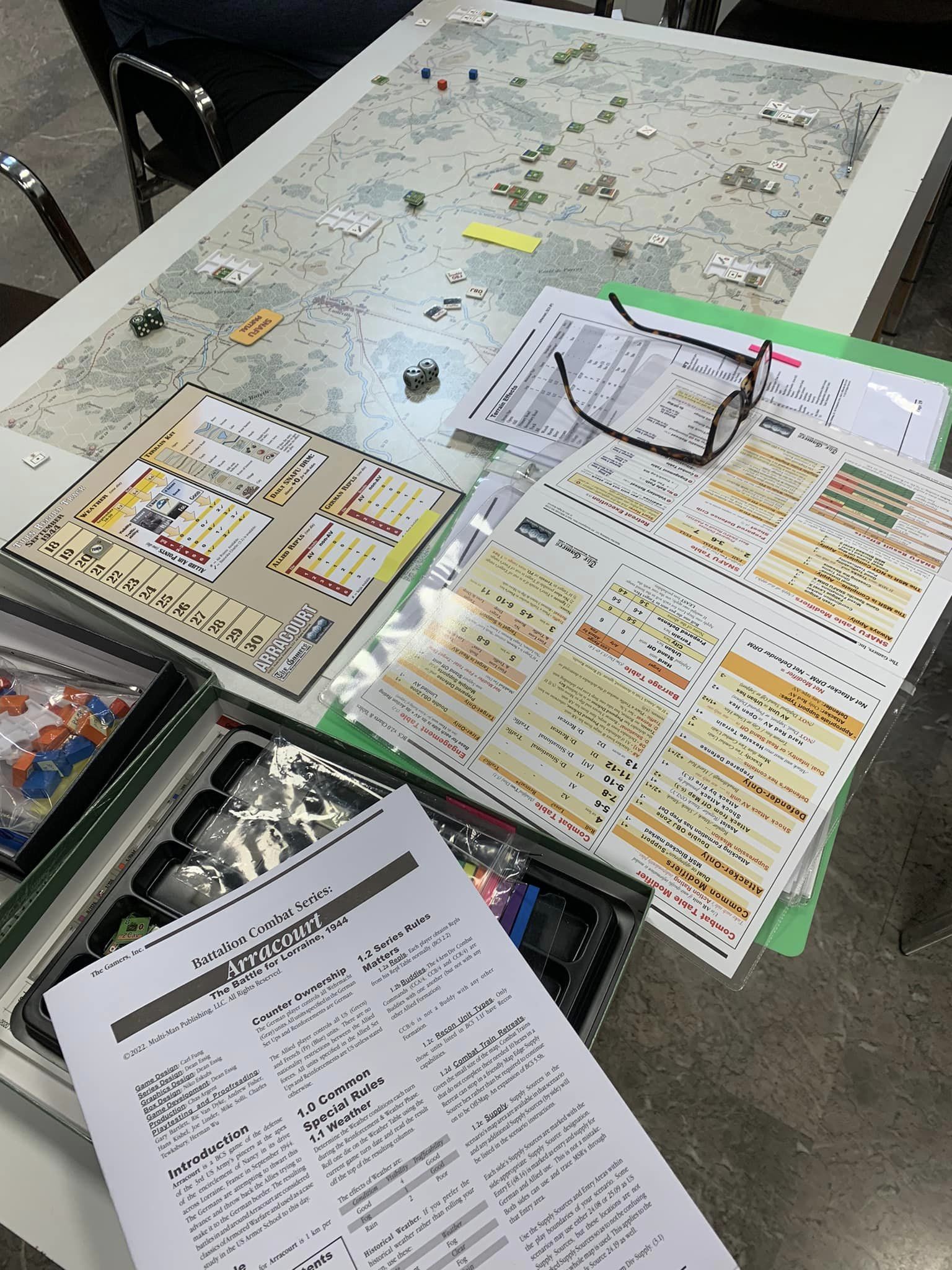PROVA SUL CAMPO
Prova sul campo rappresenta “la voce” dei soci A.S.G.S. in merito a vecchie e nuove simulazioni che il mercato dei board-wargames offre. Una serie di pagine dove poter trovare piccole recensioni e/o resoconti di partite sui board-wargames che vengono giocati dal gruppo. Siamo sempre alla ricerca anche di collaboratori; se volete inviare articoli su giochi che amate e conoscete, contattate l’Amministratore.
A partire dal gennaio 2018 si pubblicheranno 2 tipi di recensione sul Mensile: PLAYTEST EFFETTIVO e POTENZIALE DINAMICO.
Il PE è una recensione basata su partite giocate; sarà quindi approfondita e potrà avvalersi di valutazioni anche da parte di altri giocatori/collaboratori.
Il PD è una recensione basata sulla “percezione del potenziale dinamico” del gioco. Piazzamento di mappe e pedine, verifica dell’ambientazione e ricostruzione storica, lettura delle regole; in pratica si “legge il gioco” invece che giocarlo. E’ l’approccio tipico del collezionista di board-wargame…

PLAYTEST EFFETTIVO
Da BGG:
The Battalion Combat Series (BCS) is a simulation of grand tactical warfare from the advent of mechanized armies in the late portion of World War I to the present. It was created to show that there is a level of warfare that has its own distinct nature and behaviors between the tactical and operational levels of war. It is neither a large scale version of one, nor a small scale version of the other.
BCS attempts to find the best balance between simulation accuracy and playability and not compromise either unduly. Ground Scale is from 500m to 2 km per hex, depending on the terrain being shown. Combat Units are generally Battalions, with some Companies. Game Rules will state the exact scale for that game.
La serie BCS della MMP






Last Blitzkrieg is the first entry in the new Series: Battalion Combat Series (MMP), which simulates combat in World War II (and beyond) at the battalion scale. Its subject is the German Ardennes offensive Wacht Am Rhein (the Battle of the Bulge) on four detailed maps (at 1km per hex) and with 1,680 counters.
Baptism By Fire is the second game in the Series: Battalion Combat Series (MMP), which took players by storm with its block buster initial release Last Blitzkrieg: Wacht am Rhein, The Battle of the Bulge. The game is designed as a more accessible entry to the system for those who want something smaller and faster than the earlier monster game. Here the wide open desert, limited number of Formations, and short scenario length provide players with a rapid and fun introduction to the series, the chance to develop their play skills to become a more effective BCS player overall, and to take a good look at this poorly understood battle.
Brazen Chariots is the third game in the Battalion Combat Series, which took players by storm with its blockbuster initial release Last Blitzkrieg: Wacht am Rhein, The Battle of the Bulge and follow-up fast playing game Baptism By Fire: The Battle of Kasserine. In Brazen Chariots, the wide-open desert, the limited number of Formations, and numerous shorter scenarios provide players with both a rapid and fun introduction to this highly acclaimed new series.
Panzers Last Stand is a Battalion Combat Series game depicting the Axis relief operations of Budapest from January to March 1945 in what became Germany’s last major offensives in the war. The campaign game covers the Konrad Operations (I, II, and III) in January 1945. There are scenarios for each of the Konrad Operations as well as Operation Southwind in February and Operation Spring Awakening in March 1945.
Arracourt is a Battalion Combat Series (BCS) game depicting the forlorn Axis counterattack to stop Patton’s drive across France in September 1944 and the stellar example of mobile US Combined Arms that stopped that offensive dead in its tracks. The rapid movement of Patton’s Third Army eastward to Nancy has led them at the end of a supply net that is being re-allocated to put emphasis on the British in the north (which resulted in Operation Market Garden). The US 4th Armored Division in the lead performed a double envelopment of Nancy and is waiting for other elements to catch up. For the German part, Hitler sees an opportunity to do two things simultaneously: To strike at the US spearhead stopping their advance and to try out his newly formed Panzer Brigades—complete with Panthers just off the assembly line but manned by crews fresh out of training. The result was a classic defense studied by the US Army still today as the “school solution” of how to defeat an armored foe in a mobile set of battles.
Valley of Tears is a Battalion Combat Series game depicting the entire 1973 Yom Kippur war from 6 Oct 73 until the ceasefire enforced by the Superpowers and the UN. As the culmination of over 20 years of research in consultation with world-class experts, Valley of Tears shows the Yom Kippur war at a level of detail not yet seen. For the first time ever, for example, the game’s maps were precisely drawn using actual tactical Israeli maps used during the war and include the official code names for hilly defensive positions in both battle areas.
Introduzione
La scatola
Tutte le scatole dei giochi pubblicati sono uno standard MMP, con belle immagini di copertina. Quasi tutte di “spessore” diverso una dalle altre, adatte a contenere i numerosi materiali di alcuni titoli.
Mappa
Tutte le mappe del sistema presentano una tipica grafica MMP, stile OCS, SCS, ecc. Precise, colori non fortissimi, esagoni numerati a “gruppi” che non a tutti piacciono ma personalmente le giudico ottime. A parte Arracourt, tutte le scatole hanno dalle 2 alle 4 mappe, quindi gli scenari campagna necessitano di ampi spazi di gioco! E, naturalmente, sono uno spettacolo per ogni “grognard”!
Tabelle
Le tabelle principali di ogni titolo sono poche (4 fogli A4), ma complete e molto chiare. In alcune scatole (PLS, LB, e penso VoT), sono presenti ulteriori specifiche tabelle. In realtà sono pubblicate altre importantissime tabelle sia nel libretto delle regole (intendo la versione 2.0) sia nel libretto di supporto (apparso da titolo PLS); suggerisco di stamparle o fotocopiarle a parte per consultarle rapidamente durante il gioco.
Pedine, counters
Anche in questo caso, standard MMP; unità belle, chiare, con colori specifici in questo caso per le varie Formazioni che sono la base del sistema BCS. Numerosi i marker atti a registrare in mappa varie situazioni quali brecce nelle difese, fortini, Formazioni “mixed”, cioè con linee che intersecano quelli di altre Formazioni, forza decrescente delle unità (perdite in step), ecc.
Regolamento / Regolamento specifico
Il regolamento di gioco, giunto alla versione 2.0, è ben strutturato e scritto ma di certo apparirà ostico a molti giocatori. In realtà la complessità non è elevata, ma il sistema è molto diverso dai soliti e necessità un approccio completamente “nuovo”; non è un sistema/gioco per tutti. In ogni caso devo dire che il regolamento offre sempre la soluzione ad ogni problema che può sorgere; c’è tutto, e la ricerca di regole o cavilli è facilitata da un ottimo indice oltre che da una sintesi dei vari concetti a fine libretto.
I regolamenti specifici di ogni scatola contengono naturalmente gli scenari, le note storiche e quelle degli autori.
Impressioni di gioco
Il sistema necessita di varie partite per poter essere capito, apprezzato e utilizzato al meglio delle sue potenzialità; come già affermato non è un gioco per tutti. A questo proposito evidenzio quanto scrive lo stesso autore nel tutorial inserito nelle ultime scatole:
BCS Primer Tips For Playing The Battalion Combat Series Well
By Doug Fitch
However, the system’s radical design means that nothing you have previously encountered in your gaming career can fully prepare you for it. While the game mechanics are quite elegant, previous gaming experience can hinder, rather than
help, your attempt to learn the system. You must throw out everything you know about playing operational level wargames when you come to BCS. To quote a certain Jedi Master, “You must unlearn what you have learned.” Combined with some new terminology, this leads to a bit of a steep learning curve for the game.
La Fase 4, Attività, è quella che occupa la maggior parte del tempo giocando sul BCS; è complessa, subito non chiara……, e prevede ragionamenti su vari aspetti. Prima di tutto bisogna capire che le unità possono muovere, combattere, muovere ancora, avere interazioni con altre, ecc. A questo proposito vedi note inserite nel Regolamento v. 2.0:
Play Note—Movement Sequencing Options:You can,for example, move unit A, move unit B, fire a Barrage, move unit C, attack a hex using A with B as Assist (A enters the hex after winning), fire another Barrage (using A as a spotter from its new hex), move unit D through the hex cleared by the attack, use D to initiate Engagements against some deeper enemy hex, move unit E through the same hole in the enemy line, attack with stack C with an assist from E… and so on.
What you can’t do, for example, is move unit A some MPs, fire a Barrage, move unit B… and then go back to finish unit A’s remaining MA, etc. You also cannot move unit A, the nmove unit B, and then go back to unit A to conduct Engagements, Shock Attacks, or Attacks by Fire. Those must be done before starting a new unit. You can, however, move unit A some, do an Engagement, Shock Attack, or Attack by Fire, move unit A some more and do another Engagement, Shock Attack, or Attack by Fire and then call a Barrage. Then move unit B so that A and B can make a regular Attack together (as Attack and Assist).
Play Note—Combat Type Integration: Learning to play the game requires understanding what types of combat to use versus the kinds of targets and the capabilities of your own units. Becoming a great player is a matter of not only knowing these things, but arranging your forces so that you have the tools available to obtain your goals as rapidly and efficiently as possible. Importantly, an expert player will know what tools to leave in the toolbox given the situation he is presented and which ones will do the needed job and how well they will do it.
Regular Attacks are set piece actions coordinated between assaulting and supporting units & fires to push the enemy out of a position on the ground. Resolve these on the Combat Table.
Shock Attacks are rapid assaults by mechanized units exploiting their protection and mobility to decisively attack an enemy location. Shock Attacks allow the attacking unit to continue movement afterwards. Resolve these on the Combat Table.
Engagements are fire exchanges between weapons platforms using AV strengths. Engagements are used to generate losses, to suppress Support, and to free friendly units for movement. Unlike Attacks, they do not represent an effort to seize terrain. Resolve these on the Engagement Table.
Attacks by Fire use AV weapons against non-AV targets. Resolve these on the Barrage Table.
Barrages use Artillery and/or Aircraft to generate Suppression effects or to inflict step losses on enemy locations. Destruction Barrages use the Barrage Table to create losses. Suppression Barrages allow the player to apply DRMs on the Combat Table, but do not inflict any step losses.
Cosa mi è piaciuto? La grande interazione fra i giocatori; la profondità nella ricerca di adottare il giusto tipo di combattimento per ogni specifico tipo di unità; le tabelle dei combattimenti, geniali, al di fuori delle classiche “rapporto – forza/risultato”; la semplicità delle linee di rifornimento e comando, che comunque influenzano non poco l’attivazione tramite il tiro “SNAFU”; le ambientazioni finora pubblicate, in particolare Tobruk.
Cosa non mi è piaciuto? alcune regole che appesantiscono il sistema; lunghezza degli scenari, specie i campagna; spazio necessario a piazzare 3/4 mappe……
Personalmente, serie assolutamente consigliata.
Alcuni link su recensioni di vari titoli della serie:
https://boardgamegeek.com/thread/2354598/battle-bordj-chambi-pass, di Mark Herman (!!!!)
____________________________________________
LIBRO DEL MESE

di Mario Troso
Napoleone bambino frequenta per cinque anni la reale scuola militare di Brienne e per un anno la reale scuola militare di Parigi da dove esce a 16 anni come ufficiale di carriera: ha imparato il mestiere di artigliere e ha nutrito la mente con storiche immagini di grandi uomini e di grandi azioni. Nel 1789 lo scoppio della rivoluzione accende la fantasia degli intraprendenti, distruggendo barriere e facendo intravedere grandi spazi nuovi. Napoleone è pronto ad agire mettendo in atto il mestiere: cannoneggia a Tolone la flotta inglese diventando generale di brigata a 24 anni, poi a Parigi i suoi cannoni sparano a mitraglia sui cittadini che minacciano l’assalto al palazzo delle Tuileries, sede della Convenzione. Entra così in politica. Il Direttorio lo promuove generale di divisione e comandante in capo dell’armata dell’interno, la più potente delle armate della repubblica. Il 18 brumaio 1799 attua il colpo di stato: diventa primo console, assume il potere assoluto e prosegue nell’azione con le più ampie vedute: è la guerra continua in Europa con la quale si costruisce l’impero francese. E poi? Poi Napoleone non si ferma in tempo; le conseguenze di come e perché l’impero fu distrutto si leggono nel presente volume.
Nota: ho avuto il piacere di conoscere ed avere come ospite il Sig. Troso durante SMGC 2023, a supporto della presentazione del gioco LGDC, vedi https://asgs.sm/smgc-2023-report/ . Persona squisita, storico di spessore, è stato un onore averlo con noi. Siamo rimasti in contatto e mi ha omaggiato di questo splendido libro. Lo ringrazio e colgo l’occasione per consigliarlo a tutti gli amanti del periodo napoleonico!




